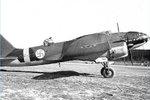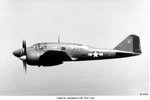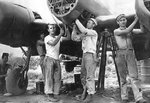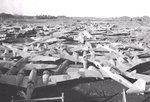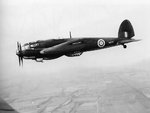- Thread starter
- #101
Polikarpov I-15bis and I-153
At least 8 I-153 had landed behind Finnish lines during the Winter War and another 3 were captured during the initial stages of the advance to the Svir. These were placed into service with the 3rd flight of LeLv 6 as cover for that unit's maritime patrol missions. It became the second flight of LeLv 30 on 16 November 1942. Prior to that it claimed the destruction of four surface ships and 5 aircraft while losing 4 I-153s, but only two of these were in combat. In November 1942 the Finns purchased another 11 captured by the Germans and these equipped the first flight of LeLv 30 in March-April '43. LeLv 30 specialized in reconnaissance. In February-March '44 both flights transferred their aircraft to the third flight and later some were received by TLeLv 16 in late June of 1944. LeLv 30 lost 7 I-153s, but only one in aerial combat. Eight survived the war.
During the Winter War the Finns captured five I-152s after they made forced landings on Finnish soil. Two of the five reached Lentolaivue (LLv) 29, the replenishment and training squadron of the Finnish Air Force. After the cease-fire, the rest of the aircraft were delivered to serve as fighter-trainers in LLv 34 After LLv 29 was disbanded, its aircraft were also handed over to LLv 34. Early in the Continuation War, LLv 34 was dissolved and the I-152s were assigned as trainers to the Täydennyslentolaivue 35 (a replenishment squadron) and two of the aircraft were placed in storage during late 1942. In mid-1943, three aircraft were transferred to the re-established LeLv 34 as target-tows. In 1944 two of the aircraft served in T-LeLv 35. After the war, the aircraft were placed in storage at the air force depot. The last flight of the I-152s in Finnish Air Force service was on 12 March 1945 when IH-4 and IH-5 were flown to the depot. The first two Finnish I-152s initially carried the registration numbers VH-10 and VH-11, while the remaining three biplanes were given serials VH-3 to VH-5. During late 1940, VH-10 and VH-11 were renumbered as VH-1 and VH-2. On 4 June 1942, the confusion regarding the numbering of war booty aircraft was resolved and the aircraft were given the serials IH-1 to IH-5.
Source: http://surfcity.kund.dalnet.se/polikarpov_finland.htm
At least 8 I-153 had landed behind Finnish lines during the Winter War and another 3 were captured during the initial stages of the advance to the Svir. These were placed into service with the 3rd flight of LeLv 6 as cover for that unit's maritime patrol missions. It became the second flight of LeLv 30 on 16 November 1942. Prior to that it claimed the destruction of four surface ships and 5 aircraft while losing 4 I-153s, but only two of these were in combat. In November 1942 the Finns purchased another 11 captured by the Germans and these equipped the first flight of LeLv 30 in March-April '43. LeLv 30 specialized in reconnaissance. In February-March '44 both flights transferred their aircraft to the third flight and later some were received by TLeLv 16 in late June of 1944. LeLv 30 lost 7 I-153s, but only one in aerial combat. Eight survived the war.
During the Winter War the Finns captured five I-152s after they made forced landings on Finnish soil. Two of the five reached Lentolaivue (LLv) 29, the replenishment and training squadron of the Finnish Air Force. After the cease-fire, the rest of the aircraft were delivered to serve as fighter-trainers in LLv 34 After LLv 29 was disbanded, its aircraft were also handed over to LLv 34. Early in the Continuation War, LLv 34 was dissolved and the I-152s were assigned as trainers to the Täydennyslentolaivue 35 (a replenishment squadron) and two of the aircraft were placed in storage during late 1942. In mid-1943, three aircraft were transferred to the re-established LeLv 34 as target-tows. In 1944 two of the aircraft served in T-LeLv 35. After the war, the aircraft were placed in storage at the air force depot. The last flight of the I-152s in Finnish Air Force service was on 12 March 1945 when IH-4 and IH-5 were flown to the depot. The first two Finnish I-152s initially carried the registration numbers VH-10 and VH-11, while the remaining three biplanes were given serials VH-3 to VH-5. During late 1940, VH-10 and VH-11 were renumbered as VH-1 and VH-2. On 4 June 1942, the confusion regarding the numbering of war booty aircraft was resolved and the aircraft were given the serials IH-1 to IH-5.
Source: http://surfcity.kund.dalnet.se/polikarpov_finland.htm
Attachments
-
 Polikarpov I-15bis 001.jpg109.3 KB · Views: 738
Polikarpov I-15bis 001.jpg109.3 KB · Views: 738 -
 Polikarpov I-15bis 002.jpg85.5 KB · Views: 314
Polikarpov I-15bis 002.jpg85.5 KB · Views: 314 -
 Polikarpov I-15bis 003.jpg125.4 KB · Views: 376
Polikarpov I-15bis 003.jpg125.4 KB · Views: 376 -
 Polikarpov I-153 Chaika 001.jpg141.3 KB · Views: 290
Polikarpov I-153 Chaika 001.jpg141.3 KB · Views: 290 -
 Polikarpov I-153 Chaika 002.jpg129.1 KB · Views: 952
Polikarpov I-153 Chaika 002.jpg129.1 KB · Views: 952 -
 Polikarpov I-153 Chaika 003.jpg146.8 KB · Views: 634
Polikarpov I-153 Chaika 003.jpg146.8 KB · Views: 634 -
 Polikarpov I-153 Chaika 004.jpg167.2 KB · Views: 481
Polikarpov I-153 Chaika 004.jpg167.2 KB · Views: 481
Last edited:



